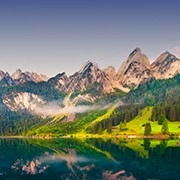Moorish Secrets of Seville

You don't realize how silent a garden can be until you're standing under the orange trees of Seville's Real Alcázar. A quiet breeze stirs the leaves, fountains bubble in the distance, and for a second, the world feels entirely still. It's in that quiet where Seville's Moorish legacy speaks the loudest.
Most travelers visit Seville for flamenco and food—but behind the tapas cafés and cobbled alleys lies a deeper story. Seville was once the seat of an empire, and that legacy is still written across its arches, courtyards, and tiled palaces.
If you want to see the city's real soul, you'll need to follow its Moorish roots—through palaces, towers, and gardens that still breathe with history.
Start with the Heart: Real Alcázar
If you only visit one place in Seville, make it the Real Alcázar—a royal palace still in use, and a rare example of Mudéjar architecture, where special artistry meets Spain.
Ticket tips:
• Entry is ~$16 USD, and you must book online in advance during peak season (April–October).
• Entry times sell out quickly—aim for a slot before 10:30 a.m. to avoid heavy crowds.
• Add the Upper Royal Rooms tour (~$5 extra) if you're into historical interiors and Game of Thrones trivia—this is where several scenes from Dorne were filmed.
As you wander through Patio de las Doncellas, take a moment to look down: the long reflecting pool isn't just decorative—it's a visual trick that doubles the arches in its reflection. From there, explore the Sala de los Embajadores, with its golden dome and interlocking geometric designs. This ceiling was constructed without nails or glue—just interlocking wooden pieces in traditional muqarnas style.
Local insight: The palace gardens stretch far beyond what most visitors see. Follow the paths behind the main fountains, and you'll find quieter corners, peacocks, and shaded benches with hardly anyone around.
Climb the Giralda: Where Cultures Meet
Next, head to La Giralda, Seville's famous bell tower—part 12th-century minaret, part Renaissance cathedral spire. Built by the Almohads in the late 1100s, it originally called Muslims to prayer. After the Reconquista, it was repurposed as a bell tower for Seville Cathedral.
Why it's unique:
• Instead of stairs, the tower has 35 gently sloping ramps—so horses could climb to the top.
• From the summit, you'll get 360° views of the city, the cathedral rooftops, and the Alcázar gardens below.
• Entry is included in the Seville Cathedral ticket (~$12 USD). Book a combined ticket to skip long lines—especially in summer when wait times often hit 45+ minutes.
Photography tip: Go late in the afternoon when the sun lights up the city in gold—ideal for skyline shots. Morning visitors get cooler weather but harsher shadows.
Don't Skip the Gardens: Maria Luisa Park
When you need a break from crowds, Maria Luisa Park is your go-to oasis—and it's just a 10-minute walk from the cathedral. The park is filled with tiled fountains, palms, Moorish pavilions, and shaded trails.
Unlike formal European gardens, Maria Luisa is designed to feel like a natural extension of the Andalusian-Moorish garden tradition—lush, winding, and filled with water features. It was originally part of the San Telmo Palace grounds and redesigned in the 20th century for the 1929 Ibero-American Expo.
What to look for:
1. Lions Fountain – tiled lions surround a shaded octagonal fountain.
2. Lotus Pond – quiet, overgrown, and less visited.
3. Tile benches – each one features a different Spanish province, arranged around Plaza de América.
Travel tip: Visit early morning or just before sunset for cooler temps and golden light. Bring water—there are few vendors inside the park itself.
Photographing Plaza de España: Know Your Angles
At the edge of the park sits the jaw-dropping Plaza de España, one of Seville's most photographed sites. Though it's not Moorish in origin (built in 1928), its horseshoe arches, ceramic tilework, and layout borrow heavily from special architectural themes.
To photograph it like a pro:
1. Arrive before 9 a.m. – before the horse carriages and tourist groups arrive.
2. Stand at the top of the bridges for a leading line shot of the canal.
3. Walk to the outer walkway, where the repeating arches and shadows make for dramatic photos.
Fun detail: Each of the 48 benches here represents a province of Spain—pick your favorite and read the tile mosaic scene.
Bonus: Catch a Traditional Flamenco Show
Though not Moorish in origin, flamenco is a cultural blend that flourished in Andalusia—layered with Arab, and local folk influences.
Skip the touristy dinner shows. Instead, book a seat at Casa de la Memoria or Museo del Baile Flamenco. Tickets are around $20–25 USD for an hour-long performance. Intimate venues mean fewer than 80 seats, and performances feel raw, emotional, and unforgettable.
Local tip: Book a late show (around 9:30 p.m.) to end your day on a high note—and avoid the midday heat.
Getting Around + Best Time to Visit
Seville's historic center is fully walkable, and most attractions are within a 15-minute radius. In summer, heat often tops 100°F (38°C)—so plan sightseeing for mornings and evenings.
Best time to visit:
• March–May (especially during Semana Santa)
• Late September–early November
If visiting in July or August, stay hydrated, take siestas, and aim for air-conditioned lodging. Public buses (TUSSAM) are frequent and cheap—under $1.50 USD per ride.
It's easy to rush through Seville's main sights, snapping photos and ticking boxes. But this city isn't meant to be rushed. It's meant to be wandered, lingered in, listened to.

Let the cool tiles of the Alcázar tell you their stories. Let the Giralda show you how faith and history share the same tower. And when the day winds down, let a single guitar string in a darkened flamenco hall remind you that beauty lives in the in-between spaces.
If you follow the path of Seville's Moorish soul—not just th

 · Travel Team
· Travel Team